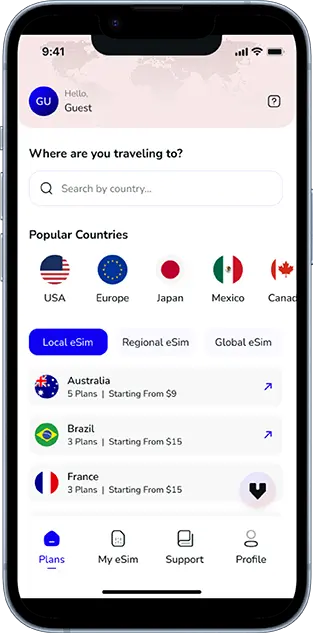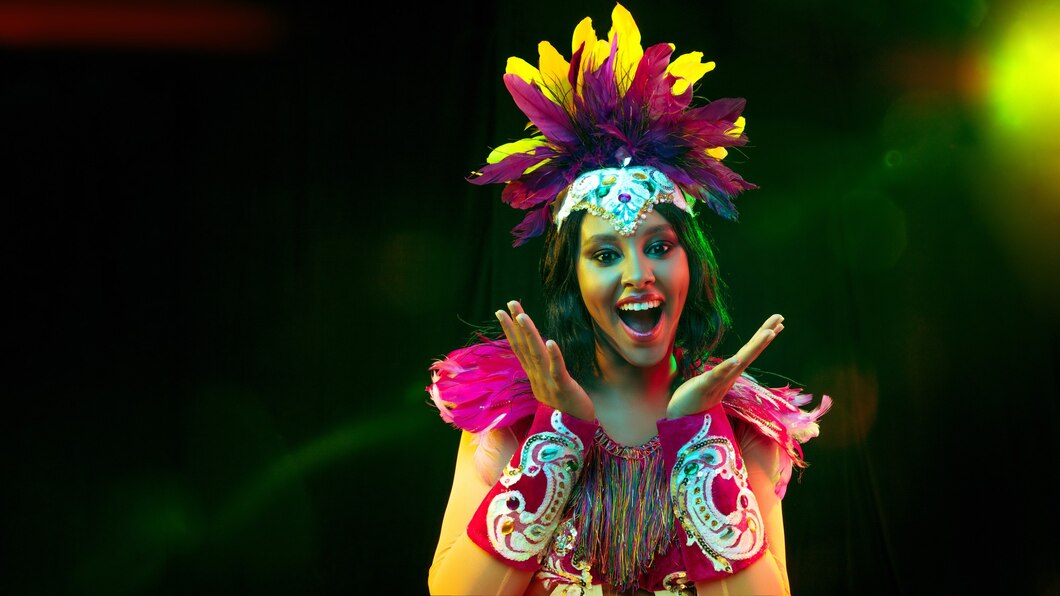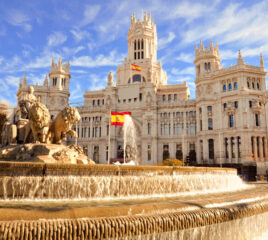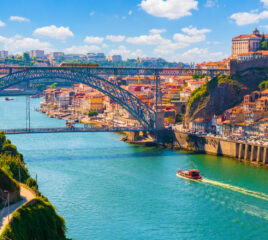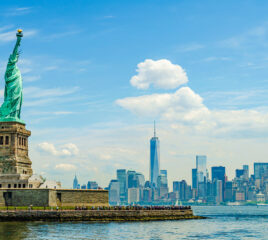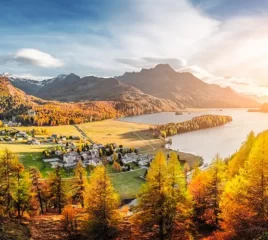Note that iPhone devices from Mainland China aren’t eSIM compatible. Also iPhone devices from Hong Kong and Macao aren’t compatible (except for iPhone 13 Mini, iPhone 12 Mini, iPhone SE 2020 and iPhone XS)
Carnival in Brazil is one of the most vibrant and iconic festivals in the world, attracting millions of people each year. This ultimate celebration of music, dance, and culture takes over the streets, with lively parades, samba rhythms, and unforgettable parties. If you’re planning to experience this spectacular event, here’s a guide to help you make the most of the festivities.
The Historical Roots of Carnival
The story of Carnival in Brazil starts with its connection to Catholic traditions. The word “Carnival” comes from the Latin phrase “carne vale,” meaning “farewell to meat.” This festival was brought by Portuguese colonizers as a way to mark the days leading up to Lent, a time of fasting and reflection. Back then, it was all about masquerade balls and formal celebrations. Over time, though, the event evolved into something uniquely Brazilian, blending European customs with influences from African and Indigenous cultures.
The Influence of Portuguese Traditions
When the Portuguese arrived in Brazil, they brought their own festival traditions, including the idea of grand masquerade balls. These events were exclusive and formal, a far cry from the vibrant street parties we see today. However, the enslaved Africans added their own cultural elements to these celebrations. They incorporated music, dance, and costumes made from natural materials like feathers and bones, paying homage to their heritage. Over time, these contributions reshaped Carnival into a more inclusive and lively event.
How Samba Became Central to Carnival
Samba is now inseparable from Brazilian festival traditions, but it wasn’t always that way. After the abolition of slavery, many freed Africans moved to Rio de Janeiro, bringing their music and dance styles with them. Samba emerged as a way for communities to celebrate and connect, even in the face of discrimination. By the 1930s, samba schools began organizing parades to showcase their art, turning the genre into a cornerstone of Carnival. Today, samba is not just music; it’s a symbol of resilience and joy, deeply tied to the spirit of Brazil’s most famous celebration.
When and Where Carnival Takes Place
The Timing of Carnival Festivities
Carnival in Brazil happens every year right before Lent, a Christian season of fasting and reflection. The official dates shift annually because they’re tied to Easter, but Carnival always kicks off on the Friday before Ash Wednesday and lasts for five days, ending on Tuesday, also known as Fat Tuesday. While these are the main days, the celebratory vibe often starts weeks earlier, with locals and tourists alike gearing up for the grand event. If you want to join in on the best places to celebrate Carnival, plan ahead because prices for accommodations and tours can skyrocket during this time.
Major Cities Hosting Carnival Celebrations
When people think of Carnival, Rio de Janeiro often comes to mind—and for good reason. It’s home to the world’s largest Carnival celebrations, with millions of participants flooding the streets and the iconic Sambadrome. But Rio isn’t the only hotspot. Salvador in Bahia offers a unique twist with its trio elétrico trucks blasting axé music through the streets, while São Paulo has a growing reputation for its vibrant parades and street parties. Recife and Olinda, in the northeast, are famous for their frevo music and colorful traditions. Each city brings its own flavor, making it hard to choose just one.
Regional Variations in Carnival Traditions
Brazil’s Carnival isn’t a one-size-fits-all event. In Rio, the focus is on samba and the elaborate parades of the samba schools. Salvador’s celebrations lean heavily on African influences, with samba-reggae and axé music taking center stage. Recife and Olinda highlight frevo, a fast-paced dance style accompanied by brass bands. Smaller towns and cities across Brazil also host their own versions of Carnival, often blending local traditions with the national spirit. Wherever you go, you’ll find a mix of music, dance, and community spirit that makes Carnival unforgettable.
The Iconic Samba Parades
What Are Samba Schools?
Samba schools are the heart and soul of Carnival in Brazil. These aren’t just dance schools—they’re community hubs, cultural institutions, and fierce competitors all rolled into one. Each samba school represents a neighborhood, often in Rio de Janeiro or São Paulo, and they work year-round to prepare for Carnival. From designing jaw-dropping costumes and floats to perfecting their samba routines, it’s a massive effort involving thousands of people. These schools are divided into levels, with the top-tier “Special Group” being the most prestigious. Winning the competition can bring pride and funding to the school, so the stakes are incredibly high.
The Sambadrome Experience
If you’re heading to Rio during Carnival, the Sambadrome is the place to be. Picture a massive open-air stadium built specifically for samba school parades. The energy is electric as each school takes its turn on the runway, performing for a panel of judges and thousands of spectators. The parades start late in the evening and stretch into the early hours of the morning. Each school has about 65-75 minutes to showcase their theme, with intricate floats, dazzling costumes, and powerful samba drumlines. It’s not just a performance—it’s a competition, and the winners are announced on Ash Wednesday. Tickets range from budget-friendly seats to VIP boxes with open bars and buffets, so there’s something for everyone.
Themes and Costumes in Samba Parades
Every samba school chooses a theme for their parade, often rooted in Brazilian history, culture, or politics. These themes guide everything from the music to the costumes and floats. The costumes are a spectacle in themselves—think feathers, sequins, and bold colors. But they’re not just for show; they’re designed to tell a story that aligns with the school’s theme. The floats are equally impressive, often towering several stories high and featuring moving parts, lights, and performers. It’s a visual and auditory feast that leaves spectators in awe.
Street Parties and Blocos
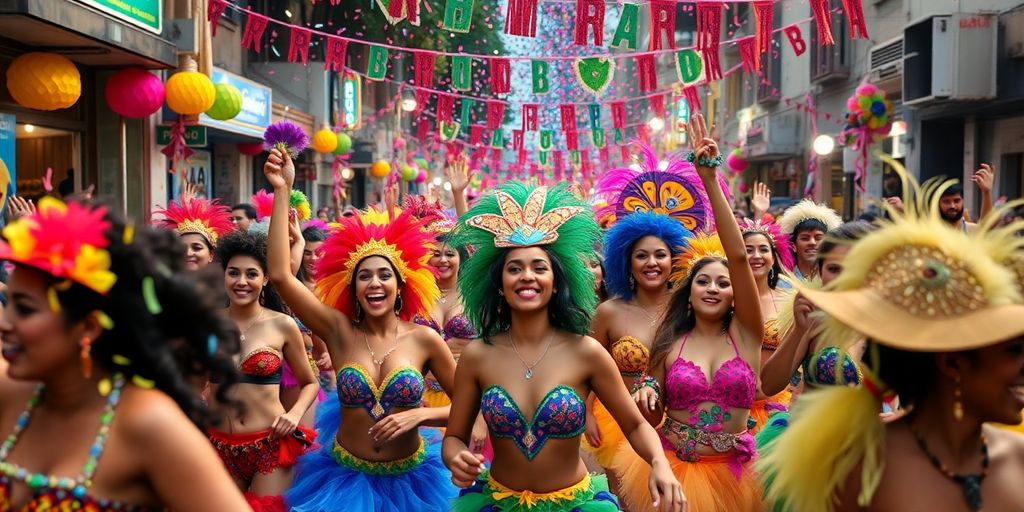
What Are Blocos?
Blocos are the heartbeat of Brazil’s Carnival, bringing the celebration from grand venues into the streets for everyone to enjoy. These are themed street parties, often led by lively bands that march through neighborhoods, drawing crowds of locals and tourists alike. Each bloco has its own unique vibe, often tied to a specific theme, and attendees are encouraged to dress up accordingly. But honestly, no one’s going to judge if you just show up in whatever costume you can throw together. It’s all about the energy and joining the fun.
Blocos are free and open to everyone, making them a more accessible way to experience the spirit of Carnival compared to the ticketed events at the Sambadrome. They’re also a throwback to Carnival’s roots, which started as street parties before evolving into the elaborate parades we see today.
Popular Blocos in Rio de Janeiro
Rio de Janeiro is the epicenter of bloco culture, hosting hundreds of these parties during Carnival season. Some of the most famous ones include:
- Cordão da Bola Preta: One of the oldest and most traditional blocos, attracting massive crowds every year.
- Simpatia é Quase Amor: Known for its playful atmosphere and catchy samba tunes, this bloco is a favorite among locals.
- Sargento Pimenta: A quirky bloco that mixes samba with Beatles songs, creating a truly unique experience.
These blocos often overlap, so it’s not uncommon to stumble from one party to another, letting the music guide your way.
Blocos in Other Brazilian Cities
While Rio might steal the spotlight, other cities have their own vibrant bloco scenes. In Salvador, for instance, blocos are accompanied by massive trio elétrico trucks equipped with sound systems and live bands. Recife and Olinda bring a different flavor with their frevo music and colorful costumes. Even São Paulo, known for its urban vibe, has embraced blocos in recent years, adding its unique twist to the tradition.
No matter where you are in Brazil, you’ll find a bloco that suits your style. Just follow the music, and you’ll end up in the middle of an unforgettable celebration.
Music and Dance at Carnival
The Role of Samba Music
Samba is the heartbeat of Brazil’s Carnival. This music style, born in the favelas of Rio de Janeiro, carries a rich history of African and Portuguese influences. Its infectious rhythms and lively beats create an atmosphere of pure joy. Samba isn’t just music—it’s a way of life during Carnival. You’ll hear it everywhere, from the grand parades to the casual street parties. Each samba school competing in the parades has its own unique song, often tied to the year’s theme, and these tunes quickly become anthems for the celebration.
Other Musical Styles at Carnival
While samba dominates, it’s not the only sound you’ll hear. In Salvador, Bahia, axé music takes center stage, blending Afro-Caribbean rhythms with Brazilian beats. Frevo, with its fast-paced and energetic vibe, is the highlight of Recife and Olinda’s celebrations. There’s also samba-reggae, a fusion that adds even more layers to the musical diversity. No matter where you are in Brazil, the music at Carnival is as varied as the country itself, ensuring there’s something for everyone to dance to.
Dance as a Form of Expression
Dance is inseparable from the music at Carnival. Whether it’s the intricate choreography of the samba schools or the spontaneous moves at a bloco, dance is everywhere. Carnival costumes and masks add an extra flair, turning every dancer into a moving piece of art. For many, dancing at Carnival isn’t just fun—it’s a way to express joy, freedom, and even cultural pride. From the graceful steps of samba to the vibrant twirls of frevo, the dances are as colorful and dynamic as the celebration itself.
Food and Drinks During Carnival
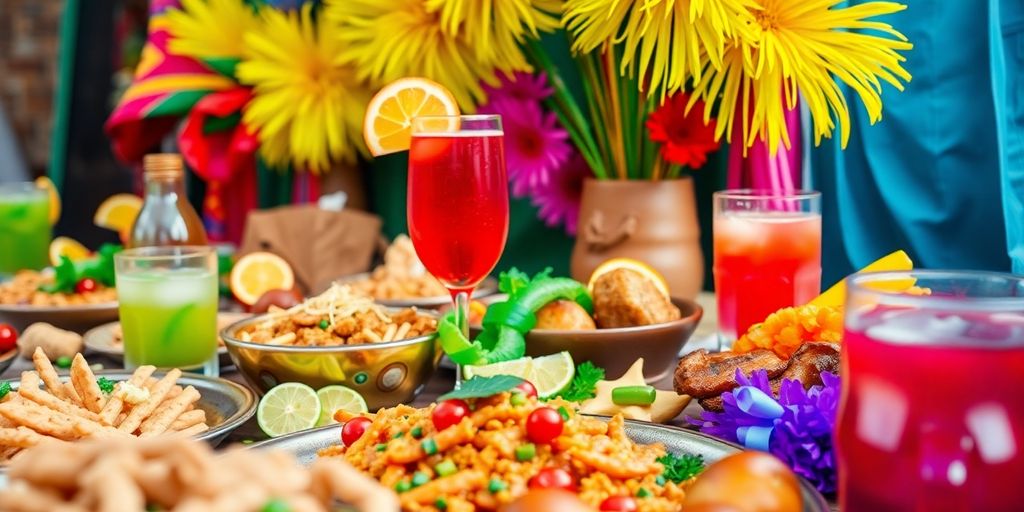
Traditional Carnival Dishes
When it comes to food during Carnival, Brazilians know how to keep the energy going with hearty and flavorful dishes. One of the most iconic meals is feijoada, a black bean stew cooked with pork cuts like sausage, ribs, and even the less glamorous parts like ears or feet. It’s traditionally served with rice, collard greens, orange slices, and farofa (toasted cassava flour). This dish is not just delicious but also deeply rooted in Brazilian history, originating from the slave era and now a Saturday favorite during Carnival.
Another dish you might encounter is acarajé, a deep-fried ball made from ground black-eyed peas, stuffed with vatapá (a creamy paste made of shrimp, peanuts, and coconut milk). This dish hails from Bahia and reflects the Afro-Brazilian influence on the country’s cuisine.
Popular Street Foods
Carnival is all about being on the move, and street food is your best friend when you’re hopping from one bloco to another. Here are a few must-try snacks:
- Coxinha: A fried dough filled with shredded chicken, shaped like a teardrop.
- Pão de queijo: Chewy little cheese bread balls that are perfect for a quick bite.
- Espetinhos: Skewers of grilled meat or cheese, often sold by street vendors.
Of course, you’ll also find plenty of sweets like brigadeiros (chocolate truffles) and churros filled with dulce de leche.
Refreshing Beverages to Try
Dancing under the hot Brazilian sun calls for drinks that keep you refreshed and hydrated. Carnival wouldn’t be complete without caipirinhas, Brazil’s national cocktail made with cachaça, lime, sugar, and ice. For a non-alcoholic option, try açaí bowls or fresh coconut water straight from the shell—both are ideal for recharging your energy.
Beer is another Carnival staple, with brands like Skol and Brahma being widely available. And if you’re feeling adventurous, give Batidas a try. These are creamy cocktails made with fruit, condensed milk, and cachaça.
Whether you’re savoring a traditional dish or grabbing a quick street snack, the food and drinks during Carnival are as vibrant and diverse as the celebration itself. Make sure to try a little bit of everything to get the full experience!
Traveling to Brazil for Carnival?
Ensure your data stays uninterrupted with eSIM.
Tips for Attending Carnival
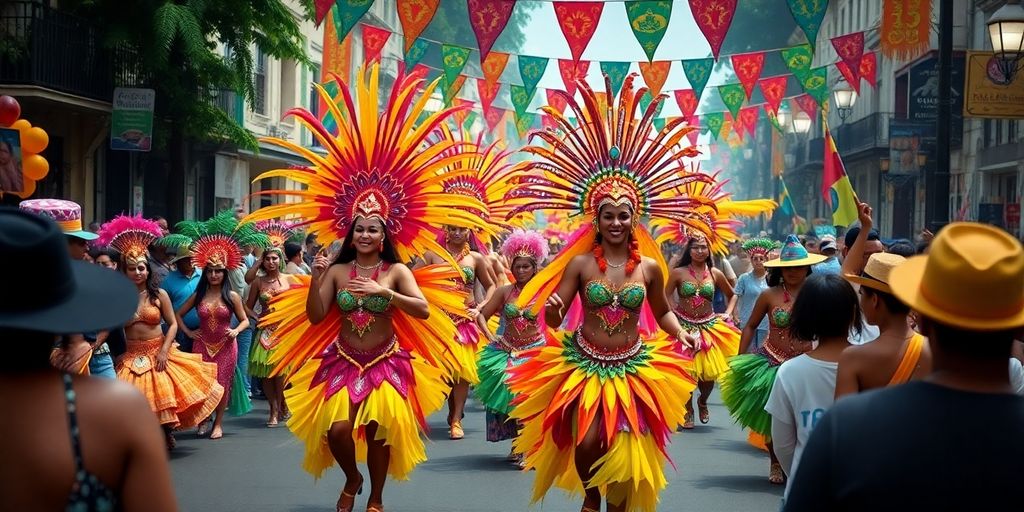
How to Prepare for Carnival
Carnival is an exciting, high-energy event, but it’s also a marathon, not a sprint. Here are a few ways to get yourself ready:
- Stay Hydrated and Energized: It’s hot, it’s crowded, and you’ll be dancing for hours. Start your day with something refreshing like açaí—it’s a local favorite for a reason. It keeps you hydrated and gives you a boost of energy.
- Plan Your Schedule: With so many blocos (street parties), parades, and events, it’s impossible to see everything. Decide in advance which ones you don’t want to miss and map out your day.
- Pack Smart: Bring essentials like sunscreen, a reusable water bottle, and some cash for street food or drinks. A small, secure bag is your best bet to keep your belongings safe.
What to Wear to Blend In
Carnival is all about self-expression, so don’t hold back when it comes to your outfit. Here’s what you need to know:
- Bright and Bold: Think sequins, feathers, and anything colorful. This is your chance to go all out.
- Comfort is Key: You’ll be on your feet a lot, so wear comfortable shoes—preferably ones you don’t mind getting a little dirty.
- Accessorize Wisely: Masks, headdresses, and glitter are all popular, but avoid anything too bulky or heavy. You’ll thank yourself later.
Staying Safe During the Festivities
Carnival is generally safe, but with such large crowds, it’s good to take some precautions:
- Stick with Friends: It’s easy to get separated, so agree on a meeting point in case someone gets lost.
- Keep Valuables to a Minimum: Leave expensive items like jewelry at home. A cheap phone case with a strap can be a lifesaver.
- Stay Aware: Watch your surroundings, especially in crowded areas. Pickpocketing can happen, so keep your belongings close.
With these tips in mind, you’re set to have an unforgettable Carnival experience. Just remember to pace yourself and enjoy every moment of this incredible celebration.
Cultural and Political Significance of Carnival
Carnival as a Cultural Celebration
Carnival is much more than a party—it’s a living, breathing expression of Brazilian culture. Rooted in centuries of tradition, it blends African, Indigenous, and European influences into a vibrant, unified celebration. Samba music, with its rhythmic beats and soulful melodies, lies at the heart of this cultural fusion. Samba schools, which began forming in the 1930s, were initially a way for marginalized communities to reclaim their cultural identity. Today, they are a symbol of pride and creativity, showcasing elaborate parades that tell stories of Brazil’s rich history and diverse heritage.
Political Themes in Samba Parades
While Carnival is known for its festive atmosphere, many samba school performances carry deep political messages. Each parade is built around a theme, and often these themes highlight social issues, historical events, or political struggles. For example, a samba school might dedicate its performance to celebrating Afro-Brazilian culture or criticizing government policies. This tradition dates back to the early days of samba schools, which used their platform to push back against oppression and inequality. Even now, the floats, costumes, and lyrics often serve as a form of protest or social commentary, making Carnival not just entertaining but thought-provoking.
The Economic Impact of Carnival
Carnival is also a major economic driver in Brazil. The festival generates billions of dollars each year, thanks to tourism, ticket sales, and the countless jobs created in sectors like hospitality, transportation, and costume design. Cities like Rio de Janeiro and Salvador see an influx of millions of visitors, both local and international, who come to experience the magic of Carnival. This economic boost helps sustain local businesses and provides opportunities for artists, musicians, and performers to showcase their talents on a global stage. However, there’s also ongoing debate about how the profits are distributed and whether the benefits reach the communities most involved in creating the spectacle.
Carnival Beyond Rio de Janeiro
Salvador’s Unique Carnival Style
Salvador, the capital of Bahia, offers a Carnival experience that’s completely different from the Rio de Janeiro parades. Here, the focus is on Afro-Brazilian culture, with music styles like axé and samba-reggae taking center stage. The city’s streets come alive with trio elétricos—massive trucks equipped with sound systems and live bands. These trucks lead the crowds through the streets, creating an electrifying atmosphere. Unlike Rio’s Sambadrome, Salvador’s Carnival is all about participation. You can join groups called blocos, purchase an abadá (a themed T-shirt that acts as your ticket), or simply enjoy the festivities from the camarotes, which are elevated viewing platforms. It’s a high-energy, inclusive celebration that highlights the diversity of Brazilian Carnival traditions.
Recife and Olinda’s Frevo Traditions
In the northeastern cities of Recife and Olinda, Carnival takes on a more traditional and artistic flair. Frevo, a fast-paced and acrobatic dance style, is the heart of these celebrations. The streets are filled with colorful umbrellas and dancers performing intricate moves to the rhythm of brass bands. Olinda, in particular, is known for its giant puppets, or bonecos gigantes, which parade through the narrow, historic streets. The atmosphere here is less commercial and more community-driven, making it a favorite for those looking to experience a more authentic side of Carnival. Don’t miss the Galo da Madrugada, Recife’s massive parade that kicks off Carnival with a burst of energy and excitement.
São Paulo’s Modern Carnival Scene
Though often overshadowed by Rio, São Paulo has carved out its own Carnival identity. The city hosts its own samba parades at the Anhembi Sambadrome, which rival the grandeur of Rio de Janeiro parades. São Paulo’s Carnival also has a thriving street party scene, with blocos catering to a wide range of musical tastes, from traditional samba to electronic and pop. What sets São Paulo apart is its modern, urban vibe. The city’s Carnival is a reflection of its cosmopolitan nature, blending traditional elements with contemporary influences. It’s a great option for those who want to experience the energy of Carnival in a more metropolitan setting.
The Global Appeal of Carnival in Brazil
Why Tourists Flock to Brazil for Carnival
Carnival in Brazil is unlike anything else in the world. Every year, millions of tourists pour into cities like Rio de Janeiro, Salvador, and Recife to experience the magic of this iconic celebration. It’s not just about the samba parades or the elaborate costumes—though those are incredible. It’s the energy, the vibe, the sense that you’re part of something bigger. For many, attending Carnival is a bucket-list experience. Travelers often plan months, sometimes even years, in advance to make sure they don’t miss out. From street parties to exclusive balls, there’s something for everyone, whether you’re a party animal or just curious about Brazilian culture.
How Carnival Influences Global Culture
Brazil’s Carnival has left its mark far beyond its borders. Samba music, for instance, has inspired countless musicians worldwide. You’ll find Carnival-style events popping up in places like Notting Hill in London or Brooklyn in New York, but they all trace their roots back to Brazil. The art of costume design, too, has been shaped by the creativity seen during Carnival. Designers and artists from around the globe often draw inspiration from the vibrant colors and intricate details of Brazilian parade costumes. Even the concept of community-driven celebrations, seen in the blocos, has caught on internationally.
Experiencing Carnival Virtually
Not everyone can hop on a plane to Brazil, but technology has made it easier than ever to join in the fun from afar. Live streams of the Sambadrome parades, virtual tours of street parties, and even online tutorials for samba dancing have opened up Carnival to a global audience. For those who can’t attend in person, this is the next best thing. It’s also a great way for people to learn about Brazilian culture and traditions without leaving their homes. Virtual experiences are especially popular among families and those who want to avoid the massive crowds while still soaking in the festive atmosphere.
Sustainability and Carnival
Eco-Friendly Practices in Carnival
Carnival, with all its grandeur, can leave a significant environmental footprint. But in recent years, there’s been a growing push to make the celebrations more eco-conscious. Samba schools and event organizers are increasingly adopting greener practices, such as:
- Using Recycled Materials: Many floats and costumes now incorporate recycled or repurposed materials, reducing waste.
- Energy-Efficient Lighting: LED lights are being used in parades and events, cutting down on energy consumption.
- Promoting Public Transport: Cities like Rio encourage attendees to use buses, subways, or shared rides to reduce vehicle emissions.
These efforts aim to balance the vibrancy of Carnival with the need to protect the planet.
Recycling and Costume Design
Costumes are a big part of Carnival’s charm, but they can also be wasteful. To address this, designers are focusing on sustainable fashion. Here’s how:
- Repurposing Old Costumes: Many samba schools now recycle costumes from past years, giving them a fresh twist.
- Biodegradable Materials: Some designers are experimenting with eco-friendly fabrics that break down naturally.
- Community Workshops: Locals are taught how to create costumes using sustainable methods, fostering a culture of reuse.
These initiatives not only reduce waste but also inspire creativity and community involvement.
The Future of Sustainable Celebrations
Looking ahead, the goal is to make Carnival a model for sustainable large-scale events. This could involve:
- Carbon Offsetting Programs: Encouraging attendees to offset their travel emissions by supporting environmental projects.
- Zero-Waste Goals: Aiming for parades and events that generate no landfill waste.
- Education Campaigns: Raising awareness about sustainability among participants and spectators.
By embracing these changes, Carnival can continue to be a celebration of life and culture without compromising the environment.
Carnival is a time of joy and celebration, but it’s also important to think about our planet. By choosing eco-friendly options, we can enjoy the festivities while protecting the environment. For example, using digital solutions like eSIMs helps reduce plastic waste from traditional SIM cards. Let’s make a difference together! Visit our website to learn more about how you can travel sustainably with Voye Global.
Wrapping Up: The Magic of Carnival in Brazil
Carnival in Brazil is more than just a festival; it’s a celebration of life, culture, and community. Whether you’re dancing in the streets of Rio, soaking in the rhythms of Salvador, or marveling at the elaborate floats in the Sambadrome, there’s something unforgettable waiting for everyone. It’s a time when the country comes alive with music, color, and joy, offering a glimpse into the heart and soul of Brazil. So, if you ever get the chance, pack your bags, embrace the energy, and dive into this once-in-a-lifetime experience. Trust me, it’s a memory you’ll cherish forever.
Stay Connected During Carnival
Get your Brazil eSIM plan for seamless connectivity.
Seamless Mobile Data Everywhere
